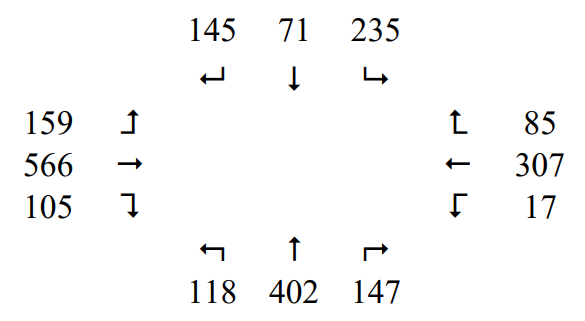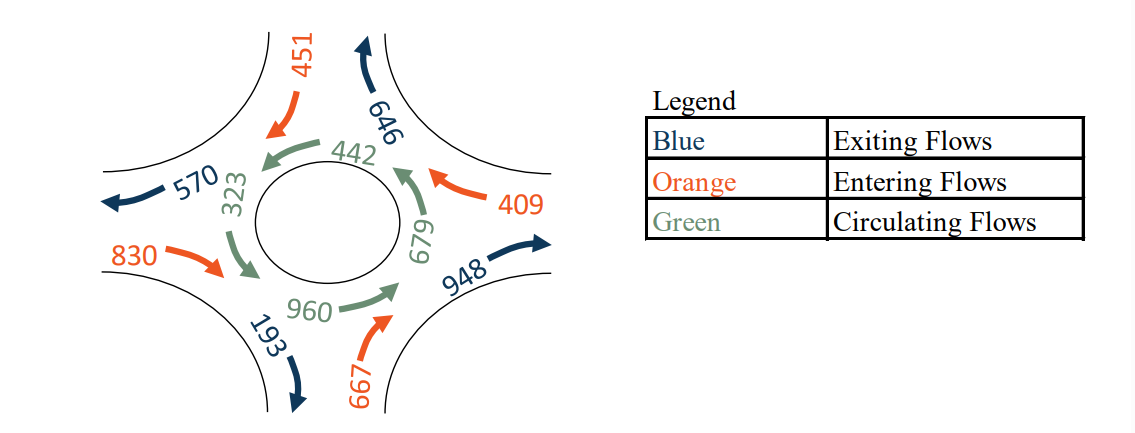Chapter 12 - Appendix M – Roundabout Analysis
Section 1: Peak Hour Capacity Evaluation
Data Requirements:
Peak Hour Factor (PHF) = .92
Percent heavy vehicles for all movements = 1.5%
Turning movement counts (TMC):

Step 1: Convert Turning Movement Counts into Flow Rates
Each of the turning movements should be divided by the PHF to convert turning movement counts into flow rates (northbound through is illustrated):

Step 2: Adjust Flow Rates for Heavy Vehicles
The flow rates can be adjusted for heavy vehicles by using the following formula (northbound through is illustrated):

The adjusted flows are now as follows:

Step 3: Calculate Entry Flow Rates
The entry flow rates are calculated by summing each movement in an approach.

Step 4: Calculate Circulating Flow Rates
The circulating flow rates are calculated by summing up the conflicting movements at each approach.

Step 5: Calculate Exiting Flow Rates
The exiting flow rates are calculated by summing up the flow rates that will be exiting at each leg.

The entering, circulating, and exiting roundabout volumes are as follows:

Step 6: Calculate Sum of Entering and Circulating Flows (volume range)

Step 7: Compare Entering and Circulating Flows to Capacity Tables
Using Exhibit 8.9 of NCHRP 1043, determine if a roundabout is feasible based on turning movement counts. As a rule of thumb, if the sum of the entering and circulating flows is less than 1,800 for each approach, a roundabout is feasible.

Multilane Roundabout Planning Considerations
The traffic analysis and geometry for a multilane roundabout operational analysis proceeds from the determination of the lane configuration. When sizing a roundabout for the number of entering and circulating lanes, each approach leg of the roundabout is evaluated individually to determine the number of entering lanes that are required. Determination of the lane configuration for multilane roundabouts follows these steps:
 As seen from the example above, the lane configuration alternatives for multilane roundabouts affects the geometric design. The diagram below shows alternative lane configurations for the same two-lane entry flows. Each one gives a different LOS result when modeled with the HCM 6 roundabout capacity equations.
As seen from the example above, the lane configuration alternatives for multilane roundabouts affects the geometric design. The diagram below shows alternative lane configurations for the same two-lane entry flows. Each one gives a different LOS result when modeled with the HCM 6 roundabout capacity equations.
- Analyze both AM and PM peak hours and the Build Year, Build Plus Ten and the Design Year forecasted traffic.
- For each approach or entry, divide the total approach volume by the number of lanes (rough check of capacity of approach i.e. single lane versus multi-lane). If the sum of entering and circulating traffic flows exceeds 1300, a multilane roundabout is likely required.
- An operational criterion for roundabouts as at most intersection is to ensure balanced queuing and demand lane by lane by designating lanes as shared or exclusive to match the expected peak hour flows.
- Divide the sum of entering and circulating flow by the number of lanes, two if the flows justify a two-lane entry.
- Draw very rough lane configuration sketches to accompany the traffic volume diagram and above-noted volume checks.
- Account for future changes in traffic patterns and volume. Consider proposing an expandable single lane roundabout if the expected flows in 10 years do not justify multilane operation.
- Complicated lane configurations compound geometric design challenges and ultimately human factors are affected. Avoid clever lane configurations that are too complex for marking maintenance ease of use by drivers.
- Development of the required lane configuration is an iterative process to determine the appropriate number of lanes and lane assignments by checking HCM 7th Edition LOS results until they are within the acceptable and a desirable range.
- Strive for simple, low conflict layouts – hybrids (1x2) vs. full 2x2 multilane layouts for safety.

